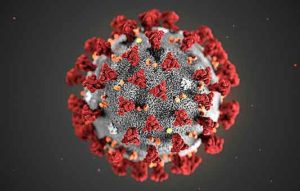
Illustration of the ultrastructure of the Covid-19 virus
CDC/SCIENCE PHOTO LIBRARY
The hook of cells used by SARS-CoV-2 to latch onto and infect cells is up to 700 times more prevalent in the olfactory supporting cells lining the inside of the upper part of the nose than in the lining cells of the rest of the nose and windpipe that leads to the lungs, scientists at Johns Hopkins Medicine report.
These supporting cells are necessary for the function/development of odor-sensing cells.
The findings, from a preliminary study of cells lining both the nose and trachea, could advance the search for the best target for topical or local antiviral drugs to treat COVID-19, and offers further clues into why people with the virus sometimes lose their sense of smell.
“Loss of the sense of smell is associated with COVID-19, generally in the absence of other nasal symptoms, and our research may advance the search for a definitive reason for how and why that happens, and where we might best direct some treatments,” says Andrew Lane, M.D., professor of otolaryngology–head and neck surgery, and director of the Division of Rhinology and Skull Base Surgery at the Johns Hopkins University School of Medicine.
Scientists have known that SARS-CoV-2 latches on to a biological hook on the surface of many types of human cells, called an angiotensin-converting enzyme 2 receptor (ACE2). The receptor reels in essential molecules.
They found high levels of ACE2 among nasal cells that give structural support called sustentacular cells.
These cells are located in an area called the olfactory neuroepithelium, where odor-sensing neurons are found.
The researchers say this area of the nose may be particularly vulnerable to infection and might be the only infected site even when there are no symptoms.
Because of this, they urge people to wear masks and wear them correctly.
For the study, depending on the biopsy sample, cells in the olfactory neuroepithelium had a 200-fold to 700-fold increase in ACE 2 proteins compared with other samples from the nose and trachea.
Because the cells with high levels of ACE2 are associated with odor sensing, the researchers suggest that infection of these cells may be the reason some people with COVID-19 experience loss of smell.
A summary of the findings appears in a letter published Aug. 19 in the European Respiratory Journal.
For more information
European Respiratory Journal
Elevated ACE2 expression in the olfactory neuroepithelium: implications for anosmia and upper respiratory SARS-CoV-2 entry and replication
Mengfei Chen, Wenjuan Shen, Nicholas R. Rowan, Heather Kulaga, Alexander Hillel, Murugappan Ramanathan Jr, Andrew P. Lane
Link…
Johns Hopkins Medicine
Link…
MDN
This post is also available in:
 Italian
Italian


